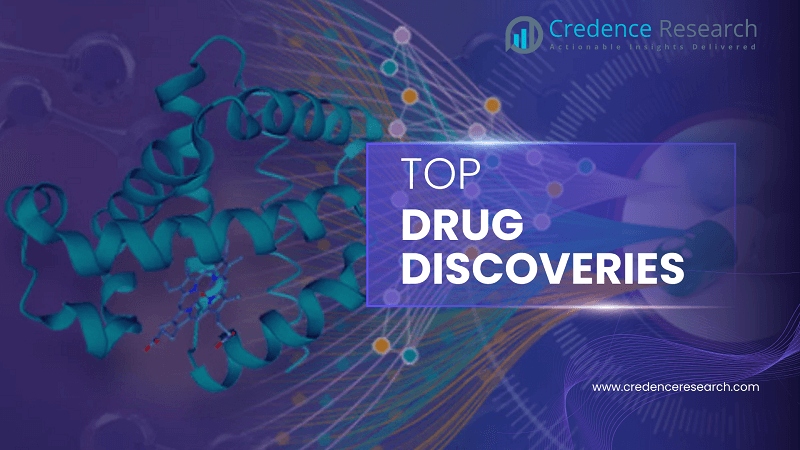Executive Summary
The year 2025 saw a significant increase in pharmaceutical innovation, resulting in groundbreaking therapies that promise to reshape the landscape of medicine. Identifying the top ten drug discoveries of the year requires a careful assessment based on novelty, impact on patient care, and market potential.
This report examines the most significant breakthroughs in infectious diseases, cardiovascular disorders, oncology, rare genetic conditions, and neurological disorders. The selection criteria give priority to drugs that have been approved by the government or have shown strong effectiveness in late-stage clinical trials, making treatments much better than they are now or meeting medical needs that weren’t being met before.
From novel antibiotics that combat drug resistance to personalized cancer vaccines and gene therapies for rare diseases, these discoveries reflect the relentless pursuit of scientific progress and hold enormous promise for improving human health in the coming years.
Novel Therapeutics for Infectious Diseases
Gepotidacin (Blujepa) for Uncomplicated Urinary Tract Infections (UTIs)
A significant breakthrough in the treatment of infectious diseases in 2025 was the FDA approval of gepotidacin (Blujepa) in March for uncomplicated urinary tract infections (UTIs) in female adults and adolescents. Developed by GSK, gepotidacin represents a novel class of oral antibiotics known as triazaacenaphthylenes. Its unique mechanism of action involves inhibiting bacterial DNA replication by targeting two essential topoisomerase enzymes: DNA gyrase and topoisomerase IV. This dual-target approach is particularly crucial in combating the growing concern of antibiotic resistance in UTI treatment. Experts emphasize that this novel mechanism allows gepotidacin to be effective against bacteria that have developed resistance to current antibiotics, including fluoroquinolones.
Gepotidacin, the first new oral antibiotic class for UTIs in nearly 30 years, received FDA approval based on two Phase III trials. EAGLE-2 demonstrated non-inferiority to nitrofurantoin (50.6% vs. 47.0% therapeutic success), while EAGLE-3 showed superiority (58.5% vs. 43.6%). The most common side effects were gastrointestinal, including diarrhea (16%) and nausea (9%), primarily mild to moderate. This approval addresses a critical need as antibiotic resistance rises in UTI treatment. As a novel triazaacenaphthylene antibacterial agent, gepotidacin represents a significant advancement for treating uncomplicated urinary tract infections, particularly against resistant bacterial strains.
Advancements in Phage Therapy
Phage therapy gained momentum in 2025 as a targeted approach against antibiotic-resistant infections. Using bacteriophages, viruses that specifically target bacteria, this treatment preserves beneficial microbiomes unlike broad-spectrum antibiotics. Clinical trials demonstrated promising results against Pseudomonas aeruginosa in cystic fibrosis patients and Escherichia coli in UTIs. Growing interest in personalized phage therapy and phage-antibiotic combinations is emerging. Despite its potential, challenges remain in developing clear regulatory pathways, standardizing production methods, and conducting rigorous clinical validation. Nevertheless, phage therapy represents an important advancement in addressing the urgent global challenge of antimicrobial resistance, offering precision treatment for drug-resistant bacterial infections.
Cardiovascular Advancements
Etripamil (Cardamyst) for Paroxysmal Supraventricular Tachycardia (PSVT)
The FDA issued a Complete Response Letter for etripamil (Cardamyst) nasal spray in March 2025, delaying approval for at-home PSVT management. This fast-acting calcium channel blocker demonstrated efficacy in clinical studies, restoring normal heart rhythm within 30 minutes of self-administration. The regulatory delay stemmed from Chemistry, Manufacturing, and Controls issues rather than safety or efficacy concerns. Once approved, etripamil could transform PSVT patient care by reducing emergency room visits. The potential remains high for this innovative self-administered nasal spray as a novel treatment option, pending resolution of manufacturing issues. The invention represents a significant advancement in cardiovascular medicine’s approach to managing paroxysmal supraventricular tachycardia episodes outside clinical settings.
Semaglutide (Ozempic) for Reducing Cardiovascular and Kidney Risks in Type 2 Diabetes with Chronic Kidney Disease (CKD)
In January 2025, the FDA approved semaglutide (Ozempic) for reducing kidney disease progression, kidney failure, and cardiovascular death in adults with type 2 diabetes and chronic kidney disease. This makes it the only GLP-1 receptor agonist approved for both cardiovascular and kidney risk reduction in this population. The approval followed the Phase 3b FLOW trial, which showed a significant 24% relative risk reduction compared to placebo. This expansion addresses a critical need for the millions affected by both conditions, as CKD is highly prevalent among type 2 diabetes patients. Medical experts consider the discovery a major advancement in managing cardiovascular-kidney-metabolic syndrome, establishing GLP-1 receptor agonists as essential treatment options for this complex patient population.
Revolutionizing Oncology Treatment
Personalized mRNA Cancer Vaccines
The field of oncology continued to be a hotbed of innovation in 2025, with significant advancements in personalized mRNA cancer vaccines. These vaccines are designed to be tailored to the unique genetic makeup of an individual patient’s tumor, harnessing the patient’s own immune system to specifically target and destroy their cancer cells. Several ongoing clinical trials in 2025 demonstrated promising results in various cancer types, including melanoma, pancreatic cancer, and non-small cell lung cancer (NSCLC). The success of mRNA vaccines during the COVID-19 pandemic has undoubtedly accelerated their application in oncology, paving the way for innovative cancer immunotherapies. Notable progress includes Moderna and Merck’s continued work together on mRNA-4157 (V940), a personalized vaccine that has a lot of potential to lower the risk of recurrence in people with melanoma.
Advancements in Antibody-Drug Conjugates (ADCs)
Antibody-drug conjugates (ADCs) became a revolutionary way to treat cancer in 2025. They combine the precision of monoclonal antibodies with the power of powerful cytotoxic drugs to kill cancer cells while leaving healthy tissue alone. Key developments included Seagen, Daiichi Sankyo, and AstraZeneca creating next-generation ADCs with enhanced linkers and payloads to improve efficacy and reduce off-target effects. Bispecific ADCs, binding to two different antigens simultaneously, gained momentum for their ability to improve tumor specificity and combat resistance. In addition to traditional cytotoxins, immune modulators and targeted protein degraders like PROTACs were added to the payloads. Increased regulatory support resulted in more approvals for ADCs across hematological malignancies and solid tumors, reinforcing their critical role in the future of precision cancer therapy.
Ivonescimab in Non-Small Cell Lung Cancer (NSCLC)
Ivonescimab emerged as a promising NSCLC treatment in 2025, with impressive Phase 3 HARMONi-2 trial results. This brand-new humanized bispecific antibody from Akeso Biopharma and Summit Therapeutics works on both the PD-1 and VEGF pathways at the same time. The study showed that patients with PD-L1 positive advanced NSCLC had a statistically significant and clinically meaningful improvement in progression-free survival compared to those who took pembrolizumab, a standard PD-1 inhibitor. Benefits were consistent across various patient subgroups, including different PD-L1 expression levels and NSCLC histological subtypes. While ivonescimab is about as safe as pembrolizumab, its dual-targeting mechanism suggests that it might be better than single-target inhibitors for first-line treatment of advanced non-small cell lung cancer. This is a big step forward in precision oncology for this difficult disease.
Mirdametinib (Gomekli) for Neurofibromatosis Type 1-associated Plexiform Neurofibromas
The FDA approved mirdametinib (Gomekli) in February 2025 as a way to treat neurofibromatosis type 1 (NF1) patients aged 2 and up who have plexiform neurofibromas that cause symptoms and can’t be completely removed surgically. This highly selective MEK1/MEK2 inhibitor was made by SpringWorks Therapeutics. It targets the overactive MAPK/ERK signaling pathway in tumors that are linked to NF1. Approval followed the successful Phase 2b ReNeu trial (NCT03962543), which demonstrated significant tumor volume reduction, pain relief, and quality of life improvements in both adult and pediatric patients. Mirdametinib represents a breakthrough as the first approved therapy specifically for adults with this condition and an important alternative for children. The drug addresses a critical unmet need for patients suffering from these disfiguring and painful nerve sheath tumors associated with this rare genetic disorder.
Telisotuzumab Vedotin in Advanced EGFR Wild-Type NSCLC with c-Met Overexpression
In 2025, a Biologics License Application was sent to the FDA asking for fast approval of telisotuzumab vedotin (Teliso-V) for people who have had EGFR wild-type nonsquamous NSCLC that has metastasized or been treated locally. This experimental antibody-drug conjugate goes after tumors that have too much c-Met, a receptor tyrosine kinase that is linked to tumor growth and EGFR inhibitor resistance. A Phase 1b study combining Teliso-V with osimertinib in c-Met-overexpressing, EGFR-mutated NSCLC patients who progressed on prior osimertinib showed promising results: a 50% objective response rate, a 7.4 months median progression-free survival, and manageable safety. Teliso-V represents a potential targeted therapy for a specific NSCLC subset with c-Met overexpression, addressing an unmet need in treatment-resistant patients and advancing personalized medicine through biomarker-directed therapy in lung cancer.
Progress in Gene Therapy for Rare Diseases
Donidalorsen for Hereditary Angioedema (HAE)
The positive Phase 3 trial results for donidalorsen in 2025 marked significant progress in the treatment of hereditary angioedema (HAE). Ionis Pharmaceuticals created donidalorsen, an experimental antisense oligonucleotide that is meant to lower the production of prekallikrein (PKK), a protein that helps start the inflammatory processes that cause HAE attacks. The number of HAE attacks was statistically significantly lower in people who were treated with donidalorsen compared to people who were given a placebo. Donidalorsen is a new way to prevent HAE attacks by focusing on the genetic production of PKK. This could mean that the drug needs to be taken less often, providing longer-lasting protection against HAE attacks compared to current treatments that mostly focus on blocking proteins already in the bloodstream. The treatment also demonstrated a favorable safety and tolerability profile in clinical studies. Based on these positive results, Ionis Pharmaceuticals is preparing to submit a New Drug Application (NDA) to the FDA, bringing this promising therapy closer to market.

